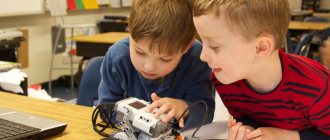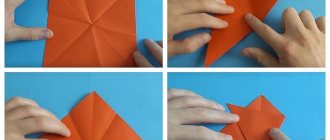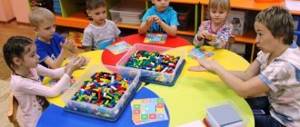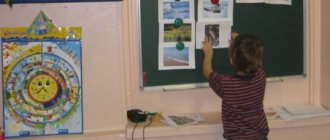Didactic games on light construction for 3-5 years old
"Find the building"
Goal: To promote the development of attention and observation. Learn to correlate what is shown on the card with buildings.
Equipment: cards, buildings, box or bag.
Children take turns taking cards out of a box or bag, looking at it carefully, calling what is depicted on it, and looking for this building. Whoever makes a mistake takes a second card.
"Who is faster"
Goal: To promote the development of speed of attention and coordination of movements.
Equipment: 4 boxes, Lego parts.
The players are divided into two teams. Each team has its own color of Lego bricks and its own part. Players move bricks one by one from one table to another. Whose team is faster wins.
"Assemble Lego bricks"
Goal: To consolidate knowledge of primary colors.
Equipment: Lego bricks of 4 colors.
Four children playing. The teacher scatters Lego bricks on the carpet, places the boxes, distributes what color bricks should be put in the box. Children choose the color they will collect. At the command “Start!” children collect bricks. The one who collects the fastest wins.
“Whose team will build faster”
Goal: Learn to build as a team, help each other. To promote the development of interest, attention, speed, fine motor skills.
Equipment: Lego set, sample.
Children are divided into 2 teams. Each team is given a sample building, for example, a house, a car with the same number of parts. The child can attach one piece at a time. Children take turns running up to the table, selecting the desired part and attaching it to the building. The team that builds the structure the fastest wins.
"Traffic light"
Purpose: To consolidate the meanings of traffic lights. Promote the development of attention and memory.
Equipment: yellow, red, green Lego bricks.
1st option: teacher - “traffic light”, the rest of the children - “cars”. The teacher shows a red light, the “cars” stop, yellow means they get ready, green means they drive.
Option 2: traffic lights and pedestrians cross the road when the light is green.
3rd option: at a red light children crouch, at a yellow light they raise their hands up, at a green light they jump in place.
Didactic games using Lego constructors
"Miracle Tree"
Purpose of the game
: - consolidate the correct pronunciation of sounds in words;
— development of phonemic perception;
- development of visual memory;
- development of fine motor skills of the fingers.
Material. Lego
, pictures for automated sound, dice.
Progress of the game
.
The game is played by 2 people. Each player has his own tree made from LEGO constructors
and a common box with
“apples”
.
They take turns throwing the dice and taking from the pack as many pictures as appear on it. The same number of “apples”
must be taken from the common box and hung on your tree.
Having taken the required number of pictures, the player clearly pronounces the name of the item shown on the card. The one who has the richest “harvest”
.
"Football"
Purpose of the game
:- automation and differentiation of sounds
“S”
and
“Sh”
;
- development of fine motor skills of the fingers;
- development of attention;
- development of phonemic perception.
Material. Lego
, dice, picture with words for the sounds
“S”
and
“Sh”
.
Progress of the game
.
On an improvised football field there are two goals made from LEGO
.
The child throws the dice for the “Whistle”
and names as many words from the picture with the sound
“C”
as appear on the dice.
After this, the same number of chips from the constructor
.
Then the player rolls the dice for the “Sizzler”
and names as many words from the picture with the sound
“Sh”
as appeared on the dice.
After this, the same number of LEGO
.
The team wins
, with the most chips.
At the end of the game
The child places
“C”
the LEGO construction set near the
“Svistelochka”
and the letter
“W”
near the
“Shipelochok”
.
"House for Lola's Doll"
Purpose of the game
: — consolidation of the correct pronunciation of the sound
“L”
in words;
— development of phonemic perception;
- development of fine motor skills of the fingers.
Material. Object pictures on the LEGO constructor
rectangular in shape (
"bricks"
) 10-14 pieces and
triangular "roof"
Progress of the game
.
The player selects “bricks”
with pictures where the sound
“L”
. He uses them to build a house for the Lola doll.
"Find a Pair"
Purpose of the game
: — consolidation of the correct pronunciation of the sound
“Рь”
in words;
- development of visual memory;
— development of fine motor skills of the fingers, phonemic perception.
Progress of the game
.
1-2 people play. LEGO
parts are laid out on the table with pictures facing up.
The child is asked to look at the pictures and remember them. After this, the LEGO
are turned over with the pictures facing down.
The child must collect the pictures from memory, connecting the parts together.
who collects the most pairs of pictures wins
"Find your soul mate"
Purpose of the game
: — consolidation of the correct pronunciation of the sound
“R”
in words;
— development of phonemic perception;
- development of fine motor skills of the fingers.
Progress of the game
. The teacher calls the word using the automated sound. The child must find 2 halves
With an image of the named word, name it, connect them together and get a picture for an automated sound.
Games that develop logical thinking.
-«Wonderful bag."
The bag contains several Lego pieces. a) The teacher shows the part that needs to be found. b) The teacher only names the required detail. c) The child needs to determine by touch what parts the model is made of.
- “Assemble the model.” Children assemble a model under the dictation of the teacher. When determining the relative position of parts, the adverbs “top”, “in the middle”, “left”, “right”, “across” are used.
2.Attention and memory.
-"What changed?". The teacher shows the children a model of 5-7 parts for some time. Then he closes the model and changes the position of 1-2 parts in it or replaces 1-2 parts with others. After which he shows the model again and asks to tell what has changed.
- “Assemble the model from memory.” The teacher shows the children a model of 3-4 parts for a few seconds, and then removes it. Children assemble the model from memory and compare it with the sample.
- “Remember and lay out the row.” A number of details are displayed in compliance with some pattern. The teacher emphasizes that for better memorization, you need to understand the pattern with which the details are placed in the sample. Children look at the sample for a few seconds and then perform the same from memory.
3.Spatial orientation.
- “Assemble the model using landmarks.” The teacher dictates to the children where to place a part of a certain shape and color. The following position references are used: “top left corner”, “bottom left corner”, “top right corner”, “bottom right corner”, “middle of the left side”, “middle of the right side”, “above”, “under”, “ to the left of", "to the right of".
- “Make a layout of the study, group and reception rooms.” For the relative position of objects in the room, a reference point is used that does not coincide with the child’s position.
4.Symmetry.
- “Lay out the second half of the pattern.” The teacher lays out the first half of the pattern, and the children must, while maintaining symmetry, lay out the second half of the pattern.
- “Make a pattern.” Children create symmetrical patterns on their own - you can depict butterflies, flowers, etc.
5.Logical patterns.
- “What’s superfluous?” The teacher shows the children a number of parts and asks them to identify the extra element (each element consists of two parts of the construction set).
-Exercises to continue the series. The teacher shows a sequence of elements consisting of construction parts, and the child must continue it.
First stage
— each element of the series consists of one design part; two features are used to create patterns.
Second phase
— each element of the series consists of two parts of the designer; one feature is used to create patterns.
Third stage
- each element of the series consists of two parts of the designer, and two features are used to form patterns.
- “Search for the missing figure.” The teacher presents a problem consisting of three horizontal and three vertical rows of figures from construction set parts. The child is given a task with one missing piece, which must be picked up. The cycle of exercises begins with the simplest tasks, when the figures consist of one part and differ in one way. Then the tasks gradually become more difficult.
6.Combinatorics.
-"Traffic light". The teacher gives the children bricks of three colors and invites them to compete to see who can make the most different traffic lights, that is, it is required that the yellow, red and green bricks be in a different order. After identifying the winner, the teacher demonstrates six combinations of traffic lights and explains the system by which they had to be compiled so as not to miss a single option.
- “Make flags.” The teacher gives the children bricks of two colors and asks them to make all possible flags from one red brick and two blue, from one red and three blue, or from two red and two blue.
7. Sets.
- “Select similar” - classification based on one property. The teacher shows the children a set of parts and uses a thread to mark a closed area. Then he sets a rule according to which the parts should be placed: for example, so that only red parts or only bricks are inside the selected area.
Games that develop the perception of shape.
“Guess it."
Target:
teach children to recognize familiar construction set parts (cube, folder, triangle, cylinder, arch, tablet, beam) by touch.
Game description:
One of the children is blindfolded and asked to guess the shape of the module by touch.
Rules of the game:
- Do not give hints or give away a shared secret.
- Do not interfere with the guesser, solve the shapes of the parts yourself.
- The guesser must conscientiously close his eyes and not remove the blindfolds until he names the detail.
- Everyone wait patiently for their turn. Only someone who does not disturb the order and does not interfere with the children playing together is chosen to guess the shape of the parts.
“Make no mistake Parsley!”
Target:
Teach children to recognize familiar construction parts by touch.
Game description:
As soon as Petrushka puts on her cap, you need to go up to the modules, select any of them, raise it higher and ask: “Parsley, Petrushka, what’s in my hands?” If Petrushka says that he doesn’t see, go up to him and put the part directly in his hands, and say along with everyone: “Parsley, touch what you have in your hands and guess what module we gave you. Make no mistake, Petrushka!”
Rules of the game:
- Maintain complete silence so that Petrushka does not make a mistake and can guess what is in his hands.
- You can’t name the module and tell Petrushka.
- Closely monitor Parsley's actions. Those who are distracted and break the rules are not chosen by Parsley.
“Do you have it or not?”
Target:
Teach children to recognize familiar construction parts by touch.
Game description:
The first child is blindfolded and asked to determine the shape of the part by touch. The second child will have to find exactly the same part in shape.
Rules of the game:
- Examine the part by touch, with both hands, turning from all sides.
- You can untie your eyes only after you have named the part.
- You need to select a part and ask if your partner has it one by one, which is established using a counting rhyme:
To have fun playing
We need to count everyone.
One, two, three, first - you!
“Bring it and show it"
Target:
Teach children to use techniques for visual inspection of shapes.
Game description:
The teacher shows a sample of the part and hides it, and the children must find the same one on their own.
Rules of the game:
- Only those children called by the teacher carry out the assignment.
- Before looking for a part, you need to take a good look at the sample and mentally imagine what you need to find.
- Before showing the children the selected part, you need to check yourself.






